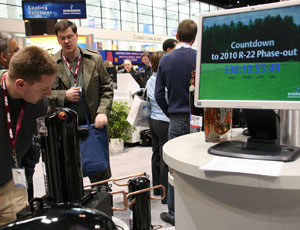A new study from the National Academy of Sciences predicts that the growing use of so-called “green” refrigerants being phased in to replace ozone-depleting ones could contribute to the global equivalent of up to 45% in carbon-dioxide emissions by 2050.

The use of hydrofluorocarbons (HFCs), such as R-404a, R-410a and HFC-134a, are set to grow exponentially as hydrochlorofluorocarbons (HCFCs), such as R-22, continue phasing out under the Montreal Protocol.
In the 1990s, HCFCs replaced more-damaging chlorofluorocarbons (CFCs). Now, HFCs are becoming the common working fluids found in newer heating, ventilating and air-conditioning systems of homes, commercial buildings, cars and power machinery. HFCs are also a byproduct of insulating foam.
New data revealed in the study show that global emissions of HFCs, which, like carbon dioxide, are considered greenhouse gases, could be greater than previously anticipated. Economic growth in established HVAC markets, in addition to non-regulated and still-developing regions, such as Asia, are expected to boost demand. In effect, the transition away from ozone-depleting fluids “has implications for future climate,” the study says.
In reaction to the report, Achim Steiner, executive director of United Nations Environment Programme, calls HFCs “other low-hanging fruit in the climate-change challenge,” adding that “action to freeze and then reduce this group of gases could buy the world the equivalent of a decade’s worth of CO2 emissions.”
Efforts to replace older-style fluids such as R-22 are well underway. Starting in January 2010, manufacturers must stop producing R-22 for new HVAC equipment, but they may still produce it to service existing units. By January 2020, recycling will still be allowed, but R-22 will be completely banned from production.


Post a comment to this article
Report Abusive Comment